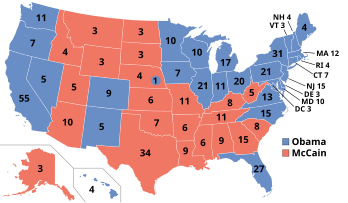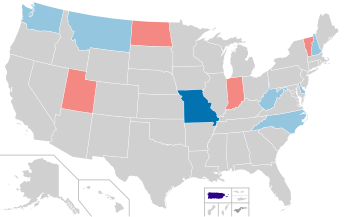|
2008 United States elections
The 2008 United States elections were held on Tuesday, November 4, 2008, during the war on terror and the onset of the Great Recession. It was considered a Democratic wave election, with Democratic Senator Barack Obama of Illinois defeating Senator John McCain of Arizona by a wide margin, and the Democrats bolstering their majorities in both chambers of Congress, thereby marking the first time since 1992 in which the Democrats won Congress and the presidency in one election. Obama won his party's presidential nomination after defeating Senator Hillary Clinton in the 2008 Democratic primaries. With Republican President George W. Bush term-limited, Senator John McCain of Arizona won the Republican nomination in the 2008 Republican primaries. Obama won the general election with 52.9 percent of the popular vote and 365 of the 538 electoral votes. Democrats picked up net gains of eight Senate seats and 21 seats in the House of Representatives on the back of Obama's coattail effect. They also won a net gain of one gubernatorial seat. The 2006 elections and 2008 elections represented the first time since 1936 that Democrats or any party made substantial gains in Congress in two consecutive elections.[1][2] This would be the last election until 2020 in which the Democrats won the presidency and unified control of Congress. This was the first presidential election year since 1964 when the Democratic Party won the White House and had coattails in the Senate and House of Representatives. The major theme during the campaign was the American public's general desire for change and reform from both Washington and the policies of President Bush. The economy and other domestic policies were also dominant issues, especially during the last months of the campaign after the onset of the 2007–2008 financial crisis. Federal electionsPresidentSenator Barack Obama of Illinois was the Democratic nominee, and Senator John McCain of Arizona was the Republican nominee. Incumbent President George W. Bush was ineligible for re-election per the Twenty-second Amendment to the United States Constitution, which limits a president to two terms, and incumbent Vice President Dick Cheney declined to run for the office. The 2008 presidential election was the first since 1952 in which neither an incumbent president nor an incumbent vice president was a candidate. Senator Obama won the number of electors necessary to be elected president and was inaugurated on January 20, 2009.[3] United States SenateThe 33 seats in the United States Senate Class 2 were up for election, plus special Senate elections in Mississippi and Wyoming. The resignation of Mississippi Senator Trent Lott, and the death of Wyoming Senator Craig L. Thomas, both Class 1 senators, meant that both of those states' senate seats were up for election. The Democrats gained 8 seats, while the Republicans did not gain a seat. United States House of RepresentativesAll seats in the House were up for election, including seats of the 435 voting representatives from the states and the 6 non-voting delegates from the District of Columbia and five U.S. territories. This marked the first time that the commonwealth of the Northern Mariana Islands selected a delegate to Congress. Democrats won the nationwide popular vote for the House of Representatives by 7.2 percentage points,[4] gaining 21 seats. They increased their total number of seats to 257, the largest number of seats held by either party in the House since Democrats lost control of Congress in the 1994 elections. State elections Democrats maintained trifecta Democrats gained trifecta Republicans maintained trifecta Divided government maintained Divided government established Officially non-partisan legislature GovernorsEleven of the fifty United States governors were up for re-election, as were the governorships of two U.S. territories. Eight incumbent state governors were running for re-election, while the retirements of Ruth Ann Minner of Delaware, Matt Blunt of Missouri, and Mike Easley of North Carolina left those gubernatorial positions open. The incumbent governors of Puerto Rico, Aníbal Acevedo Vilá, and American Samoa, Togiola Tulafono, were also up for re-election. The only governorship that changed party hands was in Missouri: Democrat Jay Nixon was elected to replace Blunt, who chose to retire instead of seeking a second term. State legislaturesElections to state legislatures were held on November 4, 2008, alongside other elections, in which Democrats scored significant gains in a blue wave election. Elections were held for 85 legislative chambers, with all states but Louisiana, Mississippi, New Jersey, Alabama, Maryland, and Virginia holding elections in at least one house. Michigan and Minnesota held elections for their lower, but not upper houses.[5] Seven territorial chambers in four territories and the District of Columbia were up. The New Hampshire Senate saw the election of the first-ever female majority. This is the first time this has occurred in any chamber of any state legislature in United States history.[6] In New York, the Democrats obtained a trifecta for the first time since 1935, and in Delaware for the first time since 1977.[7] The Democrats took control of six legislative bodies to the Republicans' four. Democrats took control of the Delaware House of Representatives, for the first time since 1985, the Montana House of Representatives, the Nevada Senate, and the New York State Senate, for the first time since 1966, the Ohio House of Representatives, and the Wisconsin State Assembly. Republicans took control of the Montana Senate; both houses of the Tennessee General Assembly,[8] for the first time since 1870; and the Oklahoma Senate, for the first time in state history. With the Montana Senate and the Montana House of Representatives flipping, this election cycle marked the last time in U.S. history as of 2025 where the upper house and lower house held by different political parties in a state legislature both flipped in the same cycle.Initiatives and referendums 80–90% 70–80% 60–70% 50–60% Vote against same-sex marriage ban by counties: 70–80% 60–70% 50–60%
References
Further reading
External linksWikimedia Commons has media related to 2008 elections in the United States.
|
||||||||||||||||||||||||||||||||||||||||||||||||||||||||||||



